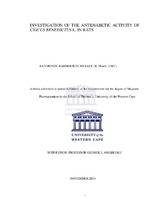| dc.description.abstract | Diabetes Mellitus, one of the major diseases affecting human population all over the
world has caused significant morbidity and mortality. The management of this
condition has raised the demand of safe and cost effective remedial measures due to
several side effects associated with the present use of modern medicines. Thus, it is
crucial to explore other options for diabetes management such as the use of medical
plants. Cnicus benedictus L. is one of the known plant species used by traditional
medicine practitioners in South Africa for the treatment of various ailments including
inflammatory conditions, pain and diabetes. Even though the plant species has been
extensively studied, scientifically, no evidence exists in literature to corroborate the
claim made by traditional medicine practitioners of its therapeutic success in the
treatment of diabetes and pain.
Therefore, the objectives of this present study were: to investigate the antidiabetic
activity of C. benedictus using leaf methanol extract of the plant species on animal
model involving male and female Albino rats; to investigate the antinociceptive
activity of the plant species on mice; to determine the safety profile of the plant by investigating the acute toxicity and to carry out HPLC study in order to characterize
the plant species.
Animals were divided into groups of six each and fasted overnight prior to the
induction of diabetes in rats using Streptozocin (STZ). The plasma glucose was
measured at intervals of 30 min for 4 hours by means of a glucometer. Cnicus
benedictus (100 – 400 mg/kg, i.p.) significantly reduced the blood glucose
concentrations of fasted normal rats with percentage maximum reduction ranging
from 46 to 79% and chlorpropramide (250 mg/kg, i.p.) significantly reduced the
blood glucose concentrations of fasted normal rats by 84%. Cnicus benedictus (100 –
400 mg/kg, i.p.) significantly reduced the blood glucose concentrations of STZinduced
diabetic rats with percentage maximum reduction ranging from 44.82 to
66.04% and chlorpropramide (250 mg/kg, i.p.) significantly reduced the blood
glucose concentration of STZ-induced diabetic rats by 71.71%.
In the oral glucose tolerance test, administration of leaf methanol extract of Cnicus
benedictus (100 – 400 mg/kg, i.p.) following oral glucose load on fasted
normoglycaemic rats significantly reduced the increased blood glucose
concentrations with percentage maximum reduction ranging from 42.45 to 70.75%.
Chlorpropramide (250 mg/kg, i.p.) following oral glucose load on fasted
normoglycaemic rats significantly reduce the increased blood glucose concentration
with a percentage maximum reduction of 79.04%. In acetic acid writhing test, animals were divided into groups of eight per dose.
Cnicus benedictus (25-400 mg/kg, i.p.) significantly reduced the number of writhes in
mice with percentage inhibition of the writhes ranging from 67.95 to 73.71%.
Indomethacin (20 mg/kg, i.p.) and paracetamol (500 mg/kg, i.p.) significantly
reduced the number of writhes in mice with percentage inhibition of 75.44 and
69.18% respectively. Combined treatment of lowest and sub-effective doses of
C.benedictus (12.5 mg/kg, i.p.) and indomethacin (10 mg/kg, i.p.) significantly
reduced the writhes with a percentage inhibition of 58.32%.
In hot plat test, animals were divided into groups of eight per dose. Cnicus benedictus
(25-400 mg/kg, i.p.) significantly delayed the reaction times of the mice to hot-plate
thermal stimulation. Morphine (10 mg/kg, i.p.) significantly delayed the reaction time
of the mice to the hot-plate stimulation.
The no-adverse-effect-level (NOAEL) of leaf methanol extract of Cnicus benedictus
was obtained at 3200 mg/kg (p.o.) and the LD50 value of the plant species was found
to be 4000 mg/kg (p.o.).
The HPLC fingerprint of the leaf methanol extract of Cnicusbenedictus showed
distinct peaks at the following retention times of 6.387, 14.628, 18.431, 23.228 and
29.829 min. In conclusion, the data obtained showed that leaf methanol extract of Cnicus
benedictus possesses both antidiabetic and antinocipetive activities. | en_US |

